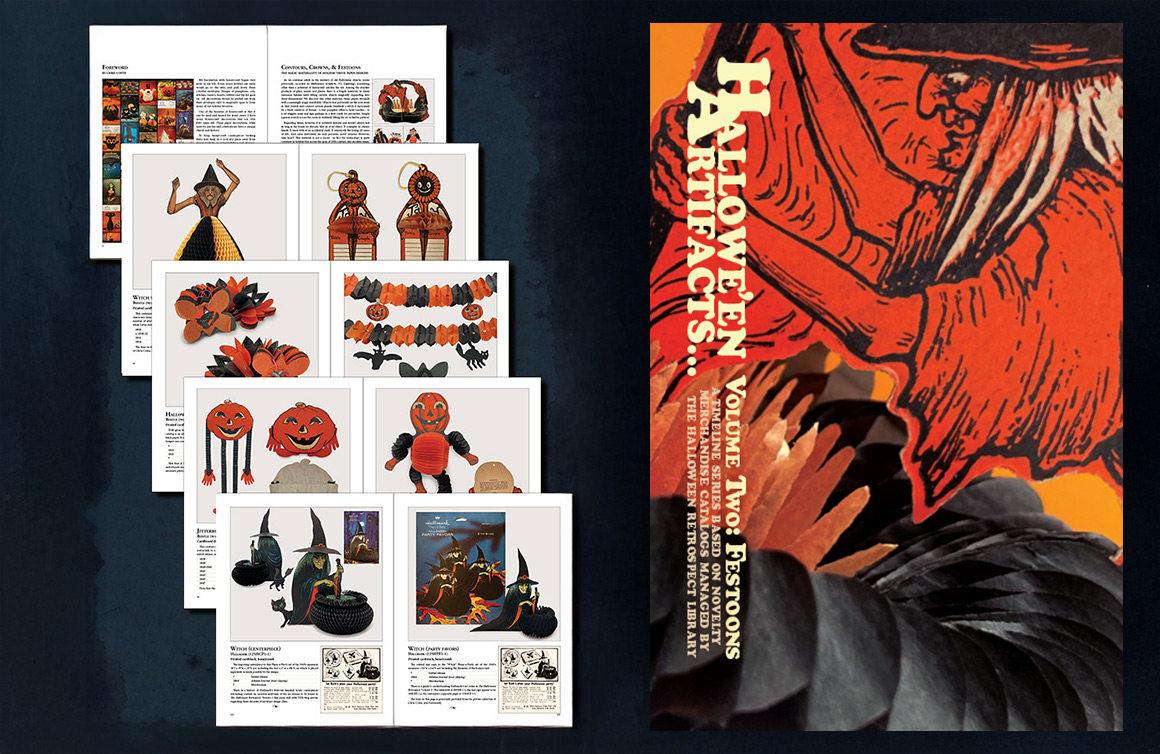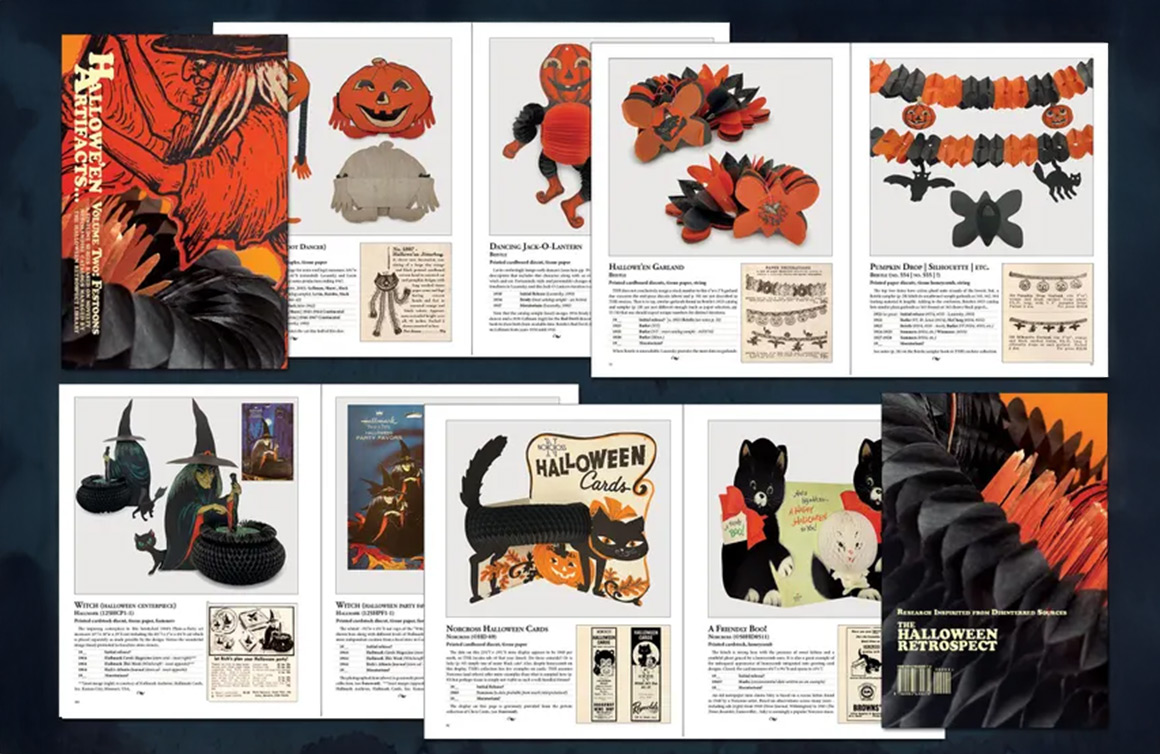Tell us about the latest volume of your Halloween Artifacts series.
Halloween Artifacts, Volume 2: Festoons, is a book celebrating vintage Halloween collectibles that incorporate tissue-paper design. These are objects that were at times marketed as decorations, at others as toys — sometimes designed for structure (solid-seeming shapes), and sometimes purely ornamental (air-ruffled fringe). The images attempt to capture the magic of this material that creates a cat spinning in a tutu, a scarecrow wiggling its limbs, or costumes brimming with spikes and tassels. The publication provides each object (or matching set) with an in-depth study not solely through descriptive imagery, but also through clippings from advertisers and vendors, as well as timelines of appearances on the market.
Halloween Artifacts, Volume 2: Festoons was released on October 21, 2025 and is the sixth self-published vintage Halloween collectibles book from The Halloween Retrospect (THR) archive and library, which studies antique and vintage-era holidays circa 1900–1980. As of this date, there is a previous Halloween Artifacts, Volume 1: Lighting, and four 32-page research digests that include fun extras like crosswords, posters, and vintage-inspired decorations.

How do you decide which pieces make it into the books — what catches your eye or feels essential?
First, THR establishes a theme that is narrow enough to be cohesive but playful enough to be exaggerated. The previous Halloween collectibles book V1:Lighting, for example, contains lanterns, shades, candle holders, and even light-charged inks. Similarly, festoons (for THR) are not restricted to a single definition (i.e., garlands) but include any object that has itself been structurally or decoratively festooned to create centrepieces, toys, or costumes.
Once there is a sufficient selection from THR’s on-site collection, I invite a remote contributor to add something extra. This approach helps round out the survey with amazing items, lacking from THR, that are often show-stoppers. For V2:Festoons, THR is thrilled to collaborate with Chris Conte (@chrisconte5), who has a great eye for honeycomb tissue paper — particularly many mid-century-era items often absent from guides compiled some ten to thirty years ago.
As for the content, THR aims for a balanced mix. Some items are famously eye-catching—considered essential or rare to longtime collectors. Others appeal to newer generations for their modern aesthetics or connection to living memories. Many objects fall somewhere in between, and I hope to strike a balance between those that have become prohibitively expensive in an overheated second-hand market and those that are still affordably acquired, even as last-minute finds (as THR often does to fill perceived gaps in book content).

What is your approach in the book series to balancing visuals and historical context?
Unlike THR digests, which are created as research articles with supporting illustrations, the Halloween Artifacts series is designed to showcase the visuals. And while that is a common approach with guidebooks, THR likes to imagine there is a difference in its own approach. THR images are intentionally large and selected to reveal an object through inventive views (and often multiple angles). They are also frequently shown with related pieces, such as original packaging. The end goal is to portray the object as artistically striking while also revealing structural information.
As for various facts about the items, the book series maintains THR’s approach of consulting vintage primary sources for data. At THR, there is a collection of approximately 650 sources (mainly catalogues) that are consulted in the hope of providing relevant information on size, availability dates, or perhaps just an unusual bit of history for each item. I would also note that this book, in particular, often draws on research by two inspiring authors who previously visited the Beistle archives: Jeannette Lasansky, who authored a book about Beistle honeycomb, and Claire Lavin, who published more than one book about Beistle’s Halloween product history. In addition, the Hallmark Archives and Framingham History Center provided valuable assistance for the current publication (and are just a couple on a long list of archives and libraries that have been helpful over the past couple of years).

Why do you think vintage Halloween imagery continues to garner interest today?
I can only speak from personal impressions, having never studied this as a greater phenomenon. But the holiday of Halloween (like other celebrations) has an early impact on our lives, as something magical travels through the world during a time of seasonal change. Maybe we can’t initially define what is in the air, but we are fascinated by the meaningfulness of decorations. That spirit ignites annually and becomes an exciting tradition. Layer that nostalgia of later years, and many people are captivated by older imagery that feels like rediscovering a lost treasure—something both familiar and strange, steeped in sentimentality for a Halloween magic that, at times, seems like a thing of the past.

How’s your personal collection of vintage Halloween ephemera grown since we spoke in 2024?
Since we last spoke, I have continued my focus on vintage references. From that previous interview with Toy Tales, your site still has some great samples of novelty catalogues that THR continues to utilize as sources for vintage Halloween collectibles books like V2: Festoons, and the reference collection continues to expand. Currently, I am up about 100 from the 550 or so we discussed previously. I’m also thrilled to continue making great connections with other collectors, archives, and libraries.
I also continue seeking affordable vintage Halloween collectibles, which I hope will eventually be included in upcoming publications (which serve as a means of cataloguing the collection). As one small example: in the V1:Lighting survey, I haphazardly overlooked many 1960s/1970s-era Halloween items designed to glow under ultraviolet light. I’ve since spent more time examining such designs, and the V2: Festoons book ends with a wonderful decoration released in 1971 by Beistle. While it would have fit perfectly in the book on lighting, it is also wonderful as a honeycomb-tissue-paper haunted-house centrepiece! Discoveries like that keep arriving — and I’m always glad to have something new from the past to share in future.

Visit The Halloween Retrospect to see more of Aaron’s collection and buy the books.



